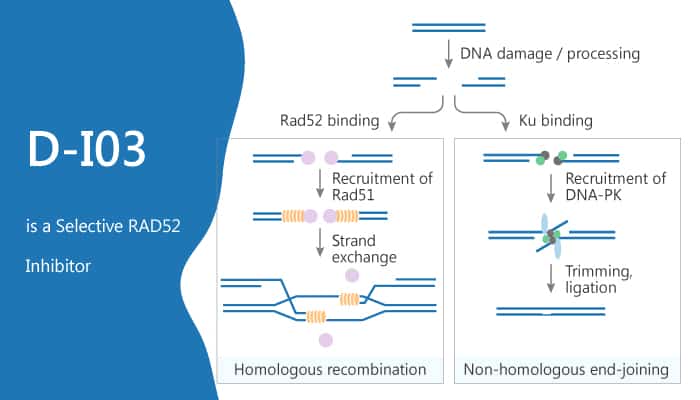DNA repair is very important for the maintenance of genome integrity in all organisms. Different exogenous agents or genotoxic products of metabolism cause multiple DNA repair systems evolved to eliminate a broad variety of DNA lesions. In normal cells, the specificities of different DNA repair mechanisms overlap to assure efficient genome protection. However, cancer cells often lose some DNA repair pathways due to intrinsic genome instability. RAD52 is a member of the homologous recombination (HR) pathway. It is important for the maintenance of genome integrity. While single RAD52 mutations show no significant phenotype in mammals, their combination with mutations in genes that cause hereditary breast cancer and ovarian cancer like BRCA1, BRCA2, PALB2, and RAD51C is lethal. Consequently, RAD52 may represent an important target for cancer therapy. In this study, D-I03 is a selective RAD52 inhibitor with a Kd of 25.8 µM.

D-I03 suppresses the growth of BRCA1- and BRCA2-deficient cells and inhibits the formation of damage-induced RAD52 foci.
D-I03 specifically inhibits RAD52-dependent single-strand annealing (SSA) and D-loop formation with IC50s of 5 µM and 8 µM, respectively. Moreover, it suppresses the growth of BRCA1- and BRCA2-deficient cells and inhibits the formation of damage-induced RAD52 foci. However, it does not affect on RAD51 foci induced by Cisplatin. Meanwhile, D-I03 treatment preferentially suppressed the growth of Capan-1 and UWB1.289 cells in a concentration-dependent manner. It also inhibits RAD52 foci formation induced by cisplatin in BCR-ABL1-positive BRCA1-deficient 32Dcl3 murine hematopoietic cell line that expresses GFP-RAD52. In the presence of D-I03, it decreases the fraction of cells with RAD52 foci from 38.7% to 171%; at the same time, the fraction of Cisplatin-treated cells without foci is increased from 48.4% to 71.9%. D-I03 does not affect on RAD51 foci induced by Cisplatin.
In summary, D-I03 can use for the development of novel cancer therapy and also as a probe to study the mechanisms of DNA repair in human cells.
Reference:
Huang F, et al. Nucleic Acids Res. 2016 May 19;44(9):4189-99.